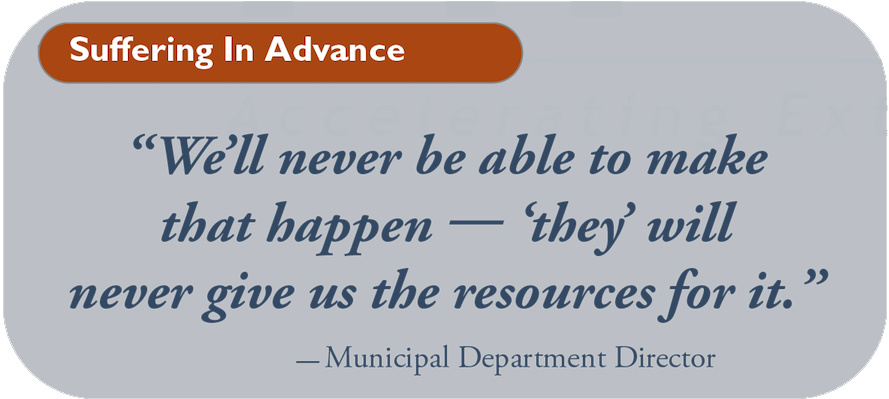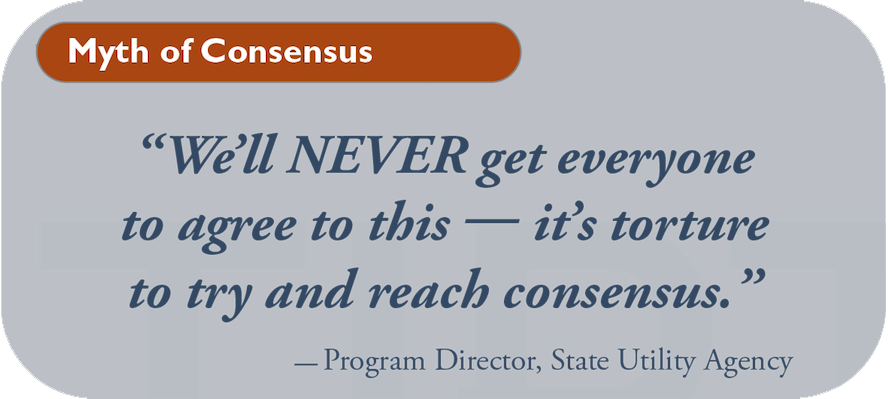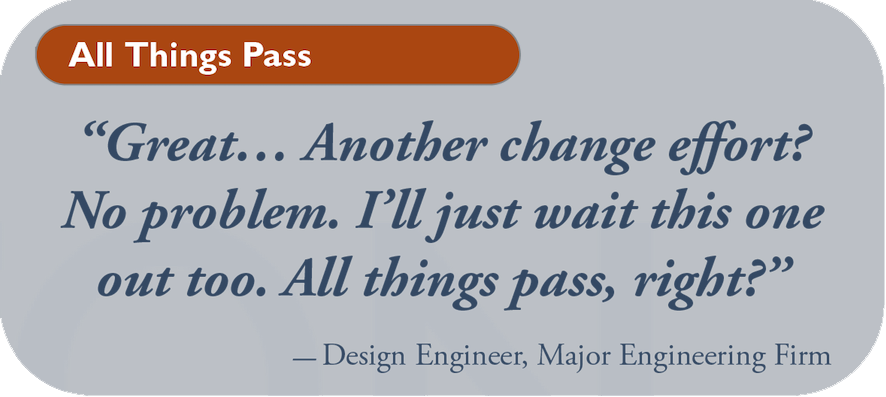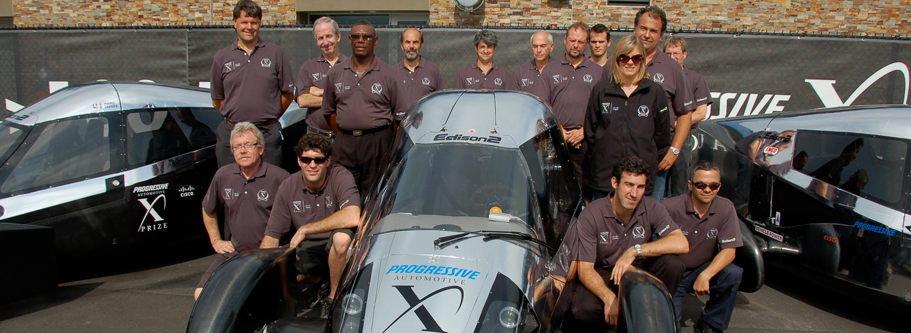
10 May The Three Toughest Barriers to Change
The Three Toughest Barriers to Change
We run into a lot of different barriers to change, but there are three that have proved to be tougher to overcome than the rest: 1) Suffering in Advance; 2) The Myth of Consensus; and 3) All Things Pass.
While each of these barriers is distinct and can stand on its own, there is one common theme running through all three: Fear. John Lennon once said, “There are two basic motivating forces: fear and love. When we are afraid, we pull back from life. When we are in love, we open to all that life has to offer with passion, excitement, and acceptance.”
Unfortunately, we see a LOT more of the former and very little of the latter — especially in work-related settings. Now, we’re not suggesting “all we need is love” (cue the music) — at least not the romantic or sing-around-the-campfire kind of love — but maybe, just maybe moving toward “acceptance” would be helpful. But — we get ahead of ourselves.
Let’s take a quick look at each of the “3 TOUGHEST Barriers to Change,” including exploring some ways to get beyond them.
Edison 2, the XPrize winner that no one really expected, or really wanted… It is a gas powered vehicle that beat out a cadre of electric vehicles.
#1 Toughest Barrier to Change: Suffering in Advance

How Does This Happen?
If you’re like us, you’ll hear something like this A LOT in meetings when someone suggests an idea: “They’ll never go for it.” Yep. They’ve just decided-in-advance what the outcome will be. They’ll never go for it. Hmmm…
When this happens, we are stuck in our fear that our ideas will be rejected. So, rather than “risking” being wrong, we simply decide ahead of time that we won’t be right. And — as a result, we suffer in advance. This fear-based barrier to change stops MOST good ideas from even seeing the light of day in my experience. It’s tragic!
“They’ll never fund it, approve it, support it, agree to it…” We hear it constantly. And, just who are “they” after all? It doesn’t matter — “they” can be board members, management, customers, coworkers, IT users, voters, family members — anyone. Regardless of the situation it seems there’s always a “they” that will disagree.
Really? Our crystal balls are THAT GOOD that we can predict the outcome — in advance? Amazing.
What Can We Do About It?
To overcome the “suffering in advance” barrier to change, we need to look differently at ourselves first, and then “give more credit” to those who will eventually be deciding something in the future.
In other words, we, ourselves, need to be secure enough to be vulnerable (how’s that for an oxymoron?) to allow ourselves to present an idea for evaluation. In order to do this, however, we need to separate ourselves (subject) from our ideas (objects). If our ideas are rejected, it is not a rejection of us. We are not our ideas — the two are totally different.
Then, we need to trust the eventual decision makers (“they”) to be capable of choosing a good outcome. Rather than suggesting what they will or won’t agree to, let THEM decide. Give them more credit! Again, in my experience, when decision-makers are trusted, they generally do a great job of making decisions.
#2 Toughest Barrier to Change: The Myth of Consensus

How Does This Happen?
Now, the title to this barrier implies that consensus is a myth. Okay — maybe you have a different opinion, but let us give you our definition of consensus (that by implication I feel is a myth): Everyone needs to feel good about an outcome or a decision before we can move forward. The key words here are “everyone” and “feel good.”
And — that’s where the myth comes in. RARELY, if ever, does everyone feel good about a proposed change. In fact, if everyone DOES feel good about the change, we worry that groupthink is present. (Groupthink: a pattern of thought characterized by self-deception, forced manufacture of consent, and conformity to group values and ethics, Merriam-Webster… Learn more about GROUPTHINK here.)
In reality, the need to make sure everyone feels good about something comes from another kind of fear — the fear of not belonging. In other words, we wait to be sure everyone goes along before we move so that no one later can accuse us of not being a team player.
What Can We Do About It?
To overcome the “myth of consensus” barrier to change, we need to recognize that team members NEED to disagree with each other — in order to create the best outcomes. Purposeful conflict is healthy and NECESSARY.
One of our team members recently attended a leadership training session where a question was asked (we paraphrase): “You are about to go into a meeting with someone who has disagreed with you in the past — how do you feel?” The “set-up” answer was in the category of anxious, nervous, shut-down, etc. However, being the trouble-maker that the team member is, he said “I feel excited! I look forward to disagreement because I know we’ll find a better answer that way.”
So… How about looking at conflict and disagreement and lack of consensus as a GOOD thing? After all, we can move forward with a change effort even if “everyone” doesn’t “feel good” (see our Nine Stages of Transformational Change post for more information).
#3 Toughest Barrier to Change: All Things Pass

How Does This Happen?
There’s a common disease in bureaucratic and institutionalized organizations — the “I waited out your predecessor, I’ll wait you out too!” sickness. Maybe it’s that we spend most of our time working with government agencies, utilities, healthcare organizations and education systems — but these groups seem to be among the best at being “change-proof” because of their culture of “I’ll wait you out…”
It’s the fear of the unknown, or the fear of uncertainty that drives the “all things pass” thinking. In fact, very much like the cycle of dysfunctional behavior present in one generation of a family to another (abuse, addiction, etc.), the “I’ll wait you out” culture will hold on to what’s known, what’s comfortable for DECADES rather than address the difficult questions needed to make substantive change.
It’s a cycle of self-fulfilling thinking, behaviors, activities and results. People are recruited, hired, trained, evaluated, promoted, and retained using the “I’ll wait you out” culture.
What Can We Do About It?
To overcome the “all things pass” barrier to change — it’s usually not enough to try and change the culture… Instead, we find it FAR more successful to create new cultures instead. As such, the process of creating leadership alignment, casting powerful, compelling, unified visions, developing relevant strategies, and building comprehensive, resource-committed plans is needed. This work is central to the process of creating new, sustainable cultures — and we find it to be successful nearly all of the time.
Why create a new culture as opposed to trying to change an existing one (particularly in an institutionalized organization)? The simple answer is this: because it works. The deeper answer? Because it “blows up” the historical biases, the long-held status quo, and the incredibly “sticky” behaviors that are part of the old culture. And — people seem to be much more positive when they’re moving toward something (a new culture) as opposed to moving away from something (dysfunction, bias, fear, etc.).
After all, it’s not so much that we fear the unknown as we fear losing the known. Help people to see strong, compelling, irresistible reasons to move forward, and their fear of losing the known abates.




Larry Rector
Posted at 17:17h, 12 MayBob,
As always, insightful and to the point.
teamtiptonadmin
Posted at 16:39h, 13 MayThank you, Larry!